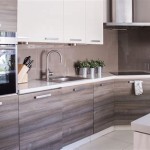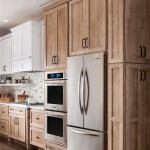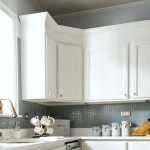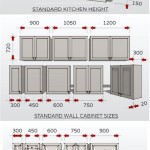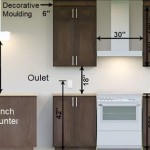Elevating Kitchen Aesthetics: The Impact of Wood Trim on Cabinets
Kitchen cabinets serve as the cornerstone of kitchen design, influencing both functionality and aesthetic appeal. While cabinet door styles and finishes often take center stage, the strategic implementation of wood trim can dramatically enhance the overall visual impact, adding depth, character, and a sense of bespoke craftsmanship to even the most utilitarian kitchen.
Wood trim, in its diverse forms, provides a versatile and customizable element for kitchen cabinet design. From simple, clean lines to elaborate, decorative profiles, wood trim can be selected and applied to complement a wide range of architectural styles and personal preferences. Its ability to introduce warmth, texture, and subtle variation in color makes it a powerful tool for creating a kitchen that feels both inviting and aesthetically refined.
The Multifaceted Roles of Wood Trim
Wood trim's contribution to kitchen cabinet design extends beyond mere ornamentation. It plays several critical roles, influencing the perception of space, highlighting focal points, and enhancing the perceived quality of the cabinetry.
One fundamental function of wood trim is to add visual interest and dimension. Flat cabinet surfaces, while practical, can sometimes appear monotonous. The addition of trim breaks up these surfaces, creating shadow lines and varying planes that catch the eye and prevent the design from feeling static. This is particularly effective in larger kitchens where expanses of uninterrupted cabinetry might otherwise feel overwhelming.
Furthermore, wood trim serves as a valuable tool for unifying the kitchen's design elements. By selecting trim styles and finishes that echo other architectural details within the space, such as baseboards, door frames, or crown molding, a cohesive and harmonious aesthetic can be achieved. This sense of unity is crucial for creating a kitchen that feels intentionally designed and well-integrated with the overall home.
Another significant role of wood trim is to accentuate specific features of the cabinetry. For instance, applied molding around cabinet doors can draw attention to their design, highlighting the chosen style and craftsmanship. Similarly, decorative trim applied to the upper cabinets can emphasize their height and create a sense of grandeur, making the kitchen feel more spacious and upscale.
Beyond its aesthetic contributions, wood trim can also serve a practical purpose. Applied to exposed cabinet edges, it protects the underlying material from wear and tear, extending the lifespan of the cabinetry. In areas prone to moisture, such as around the sink or dishwasher, wood trim can provide an additional barrier against water damage, safeguarding the cabinets from warping or deterioration. This protective function makes wood trim a worthwhile investment, particularly in high-use kitchens.
Exploring Different Types of Wood Trim
The selection of wood trim is a critical decision, as the style and finish will significantly impact the overall look and feel of the kitchen. A wide variety of trim profiles and wood species are available, each offering unique characteristics and visual appeal. Understanding the different options is essential for making informed choices that align with the desired aesthetic.
One of the most common types of wood trim is crown molding, which is typically installed at the top of the upper cabinets, bridging the gap between the cabinets and the ceiling. Crown molding adds a sense of formality and elegance to the kitchen, making it feel more polished and refined. It is available in a wide range of styles, from simple, minimalist designs to elaborate, ornate profiles, allowing for customization to suit various tastes.
Another popular option is base molding, which is installed along the bottom of the lower cabinets, where they meet the floor. Base molding provides a finished look and protects the cabinets from scuffs and damage. Like crown molding, it is available in a variety of styles and sizes, allowing for seamless integration with the existing baseboards in the kitchen.
Applied molding, also known as door or panel molding, is used to embellish cabinet doors and drawer fronts. It can be applied in a variety of patterns, such as raised panels, recessed panels, or beaded panels, adding depth and visual interest to the cabinet surfaces. Applied molding is particularly effective for creating a more traditional or transitional kitchen aesthetic.
Beyond these standard types of wood trim, there are also various decorative trims available, such as corbels, onlays, and valances. Corbels are decorative brackets that are typically used to support countertops or shelves, adding a touch of architectural detail. Onlays are decorative elements that are applied to the surface of the cabinets, adding visual interest and texture. Valances are decorative panels that are installed beneath the upper cabinets, concealing under-cabinet lighting or adding a decorative touch.
The choice of wood species is also an important consideration. Different wood species have different grain patterns, colors, and textures, each contributing a unique character to the kitchen. Maple, oak, cherry, and walnut are common choices for wood trim, each offering distinct aesthetic qualities. Maple is known for its smooth, even grain and light color, making it a versatile choice for a variety of styles. Oak is known for its prominent grain pattern and warm, golden tones, making it a popular choice for traditional kitchens. Cherry is known for its rich, reddish-brown color and smooth texture, adding a touch of elegance to the kitchen. Walnut is known for its dark, dramatic color and intricate grain pattern, making it a sophisticated choice for modern kitchens.
Strategies for Integrating Wood Trim into Kitchen Cabinet Design
Successfully integrating wood trim into kitchen cabinet design requires careful planning and consideration. The goal is to create a cohesive and visually appealing design that enhances the overall aesthetic of the kitchen. Several strategies can be employed to achieve this.
One key strategy is to maintain consistency in style and finish. The wood trim should complement the overall style of the kitchen, whether it is traditional, contemporary, or transitional. Selecting trim profiles and finishes that align with the existing architectural details and design elements will create a sense of harmony and unity. Mismatched trim styles can create a disjointed and unattractive look.
Another important strategy is to consider the scale and proportion of the trim. The size of the trim should be appropriate for the size of the cabinets and the overall size of the kitchen. Overly large trim can overwhelm smaller cabinets, while overly small trim may be insignificant and unnoticeable in larger kitchens. Careful consideration of the scale and proportion will ensure that the trim enhances the design without being distracting.
Furthermore, it is essential to pay attention to the placement of the trim. Strategically placing trim can highlight specific features of the cabinetry and create visual interest. For example, applying crown molding to the upper cabinets can emphasize their height and create a sense of grandeur. Applying applied molding to cabinet doors can draw attention to their design and add depth and dimension. Careful placement of the trim will maximize its impact and enhance the overall aesthetic of the kitchen.
The choice of finish for the wood trim is also crucial. The finish should complement the color and finish of the cabinets and the overall color palette of the kitchen. A clear finish can highlight the natural beauty of the wood grain, while a painted finish can add a pop of color or create a more uniform look. Careful consideration of the finish will ensure that the trim seamlessly integrates with the existing design elements.
Finally, it is important to consider the overall budget when selecting wood trim. Wood trim can range in price from relatively inexpensive to quite costly, depending on the type of wood, the profile, and the finish. Setting a budget upfront and selecting trim options that fall within that budget will help to avoid overspending. There are many affordable trim options available that can still provide a beautiful and impactful design.
By carefully considering these strategies, homeowners and designers can effectively integrate wood trim into kitchen cabinet design, creating a kitchen that is both beautiful and functional. The strategic use of wood trim can elevate the overall aesthetic, adding depth, character, and a sense of bespoke craftsmanship to even the most modest kitchen.

Decorating With Stained Trim Cabinetry Lindsey Putzier

Decorating With Stained Trim Cabinetry Lindsey Putzier

Adding Wood Trim To Kitchen Cabinets

Oak Floors And Trim With White Cabinets Grayish Counter Tops Interior Design Kitchen Home Decor

16 Best Wall Colors To Go With Stained Wood Trim Dark Kitchen Cabinets

Can You Have White Painted Cabinets With Stained Trim

20 Amazing Antique Kitchen Cabinets Home Design Lover White Interior

Can You Have White Painted Cabinets With Stained Trim

Adding Wood Trim To Kitchen Cabinets

How To Paint Ugly Oak Strip Cabinetry The Sweetest Digs
Related Posts



